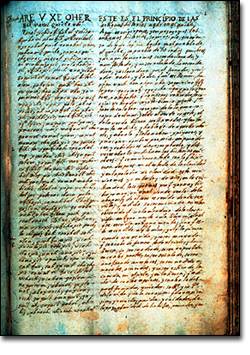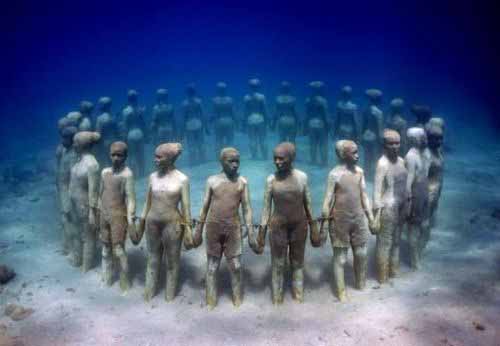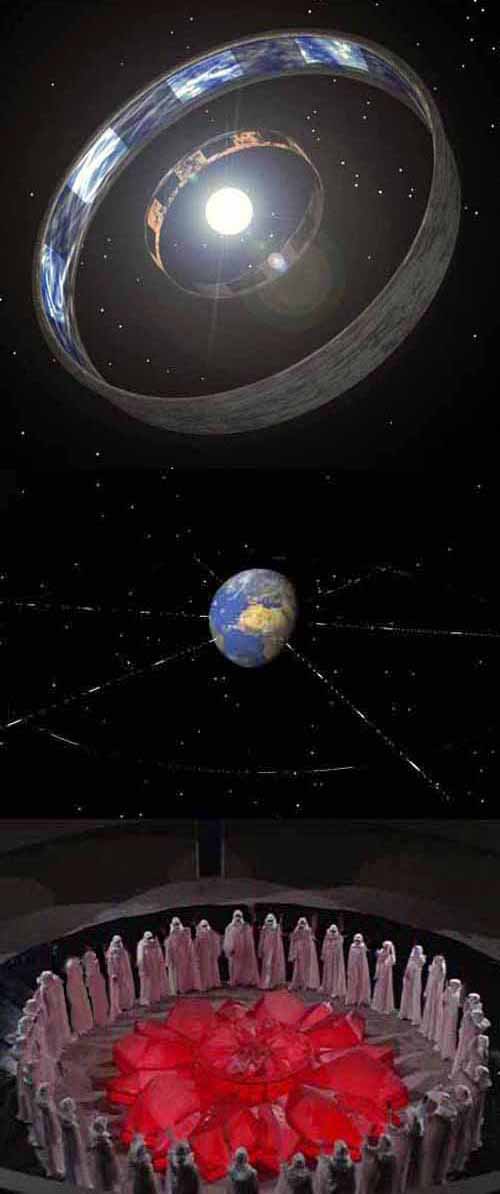
The Popol Vuh "Council Book" or "Book of the Community") is a book written in the Classical Quiché language containing mythological narratives and a genealogy of the rulers of the post classic Quiché Maya kingdom of highland Guatemala.
The book contains a creation myth followed by mythological stories of two Heroic Twins: Hunahpu (Junajpu) and Xbalanque (XbŒalanke). The second part of the book deals with details of the foundation and history of the Quiché kingdom, tying in the royal family with the legendary gods in order to assert rule by divine right.
The book is written in the Latin alphabet but is thought to have been based on an original Maya codex in the Mayan hieroglyphic script. The original manuscript which was written around 1550 has been lost, but a copy of another handwritten copy made by the Friar Francisco Ximénez in the early 18th century exists today in the Newberry Library in Chicago.
The significance of the book is enormous since it is one of a small number of early Mesoamerican mythological texts-it is often considered the single most important piece of Mesoamerican literature. The mythology of the Quiché is believed to correspond quite closely to that of the Pre Classic Maya, as depicted in the San Bartolo murals, and iconography from the classic period often contains motifs that are interpretable as scenes from the Popol Vuh.
History
The original manuscript, called "The manuscript of Quiché," was written in Santa Cruz Quiché around 1550-1555. It is thought to have been written down from an oral recitation of a hieroglyphic manuscript that has since been lost. It was obviously written after the first missionaries arrived in Santa Cruz Quiché in the 1540s and is assumed to have been written before 1558. Judging from the genealogical part of the work, in which a prominent place is given to the Kaweq lineage, the author may have belonged to this lineage as opposed to the other royal Quiché lineages, the Nijaib, the Tam and the Ilok'ab lineages. Some have speculated that the author was a certain Diego Reynoso, also the author of another Quiché document, the Titulo de Totonicapán. Van Akkeren (2003) discards Reynoso as the author of the Popol Vuh, since the viewpoint in the Titulo de Totonicapan is biased against the Kaweq lineage - he thinks that the authors were in fact the heads of a faction of the Kaweq lineage called the Nim Ch'okoj.
Whoever the original authors were, The Quiché Manuscript was found in the Chichicastenango by the Dominican priest Francisco Ximénez in the early 18th century. He translated and copied the manuscript and added it as an appendix to his grammatical work "Arte de Tres Lengvas: Kaqchikel, Quiché y Tzutuhil". This manuscript was kept in a neglected corner of the Universidad de San Carlos library in Guatemala City, until it was discovered by Abbé Brasseur de Bourbourg and Carl Scherzer in 1854. However, "the Chichicastenango manuscript" has disappeared from history. Brasseur and Scherzer published French and Spanish translations a few years later.
Brasseur de Bourbourg in Rabinal found another copy of the Chichicastenango manuscript, also made in the early 18th century. Brasseur de Bourbourg brought the manuscript to Paris. Following his death, it was sold and resold and eventually wound up in the Chicago Newberry Library. This copy of Ximenéz' copy of the original Quiché manuscript is the earliest extant manuscript of the Popol Vuh.
Since Brasseur de Bourbourg's and Scherzer's first translations, the Popol Vuh has been translated into English and other languages. The Popol Vuh is considered one of the literary treasures of the Americas.
Summary
Part 1
- Gods create world.
- Gods create first "wood" humans, they are imperfect and emotionless.
- Gods destroy first humans in a "resin" flood; they become monkeys.
- Twin diviners Hunahpu & Xbalanque destroy arrogant Vucub-Caquix; then Zipacna & Cabracan.
Part 2
- Diviners Xpiyacoc and Xmucane beget brothers.
- HunHunahpu & Xbaquiyalo beget "Monkey Twins" HunBatz & HunChouen.
- Cruel Xibalba lords kill the brothers HunHunahpu & VucubHunahpu.
- HunHunahpu & Xquic beget "Hero Twins" Hunahpu & Xbalanque.
- "Hero Twins" defeat the Xibalba houses of Gloom, Knives, Cold, Jaguars, Fire, Bats.
Part 3
- The first 4 "real" people are made: Jaguar Quiché, Jaguar Night, Naught, & Wind Jaguar.
- Tribes descend; they speak the same language and travel to TulanZuiva.
- The tribes language becomes confused; and they disperse.
- Tohil is recognized as a god and demands life sacrifices; later he must be hidden.
Part 4
- Tohil affects Earth Lords through priests; but his dominion destroys the Quiche.
- Priests tried to abduct tribes for sacrifices; the tribes tried to resist this.
- Quiche found Gumarcah where Gucumatz (the feathered serpent lord) raises them to power.
- Gucumatz instituted elaborate rituals.
- Genealogies of the tribes
Creation Myth
The book begins with the creation myth of the K'ichee' Maya, which credits the creation of humans to the three water-dwelling feathered serpents:
- There was only immobility and silence in the darkness, in the night. Only the Creator, the Maker, Tepeu, Gucumatz, the Forefathers, were in the water surrounded with light. They were hidden under green and blue feathers, and were therefore called Gucumatz...
and to the three other deities, collectively called "Heart of Heaven":
- Then while they meditated, it became clear to them that when dawn would break, man must appear. Then they planned the creation, and the growth of the trees and the thickets and the birth of life and the creation of man. Thus it was arranged in the darkness and in the night by the Heart of Heaven who is called Huracán. The first is called Caculhá Huracán. The second is ChipiCaculhá. The third is Raxa-Caculhá. And these three are the Heart of Heaven.
who together attempted to create human beings to keep him company.
Their first attempts proved unsuccessful. They attempted to make man of mud, but man could neither move nor speak. After destroying the mud men, they tried again by creating wooden creatures that could speak but had no soul or blood and quickly forgot him. Angered over the flaws in his creation, they destroyed them by tearing them apart. In their final attempt, the ³True People² were constructed with maize. The following is an excerpt of this myth:
- They came together in darkness to think and reflect. This is how they came to decide on the right material for the creation of man. ... Then our Makers Tepew and Q'uk'umatz began discussing the creation of our first mother and father. Their flesh was made of white and yellow corn. The arms and legs of the four men were made of corn meal.
Today the Popol Vuh continues to be an important part in the belief system of many Quiché. Although most are now Catholic, they continue to blend Christian and indigenous beliefs. The original text is seen as difficult to understand, and a simplified version, Popol Vuh: A Sacred Book of the Maya, has now been published in English, Hungarian and Spanish, targeted towards adult and children who are unfamiliar with the Maya.
Other Sources
Classic Maya pottery shows some of the main characters of the mythological part of the document, such as the Maya Hero Twins and the Howler Monkey Gods. Certain scenes have been interpreted as referring to the 16th-century version of the myth, in particular the shooting of Vucub-Caquix and the restoration of the Twins' dead father (see Maya maize god). This opens up the possibility that the accompanying sections of hieroglyphical text are ancestral to passages from the Popol Vuh. Some stories from the Popol Vuh continued to be told by modern Maya as folk legends; some stories recorded by anthropologists in the 20th century may preserve portions of the ancient tales in greater detail than the Ximénez manuscript.

Maya Creation Myths - Mud People





0 comments:
Post a Comment